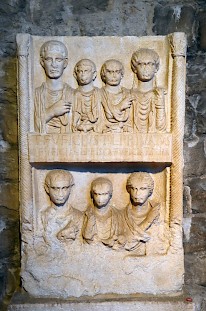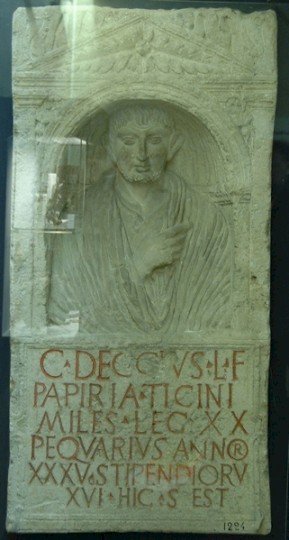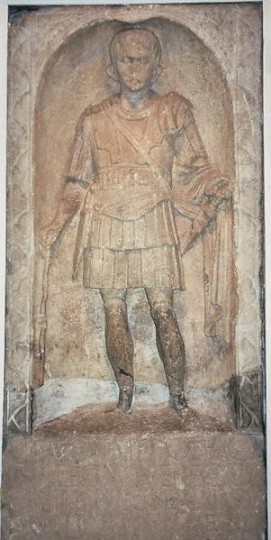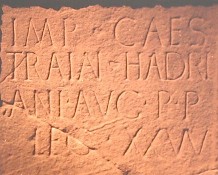Legio XX Valeria Victrix
Legio XX Valeria Victrix: one of the Roman legions. The natural way to read the name is "victorious black eagle", although it can also be read as "valiant and victorious".

This legion was probably founded after 31 BCE by the emperor Augustus, who may have integrated older units into this new legion. Its first assignment was in Hispania Tarraconensis, where it took part in Augustus' campaigns against the Cantabrians, which lasted from 25-13 BCE. This was one of the largest wars the Romans ever fought. Among the other troops involved were I Germanica, II Augusta, IIII Macedonica, V Alaudae, VI Victrix, VIIII Hispana, X Gemina, and perhaps VIII Augusta. Veterans were settled at Mérida.
At least some subunits of XX Valeria Victrix were transferred to Burnum on the Balkans as early as 20. This is probably too early for the redeployment of the entire legion, but we can be certain that the entire unit was sent to the Balkans before the beginning of the common era. It seems to have stayed at Aquileia, east of modern Venice, and may have played a role during the war in Vindelicia.note

In 6 CE, Tiberius was to lead at least eight legions (VIII Augusta from Pannonia, XV Apollinaris and XX Valeria Victrix from Illyricum, XXI Rapax from Raetia, XIII Gemina, XIV Gemina and XVI Gallica from Germania Superior and an unknown unit) against king Maroboduus of the Marcomanni in Czechia; at the same time, I Germanica, V Alaudae, XVII, XVIII and XIX were to move against Czechia as well, attacking it along the Elbe. It was to be the most grandiose operation that was ever conducted by a Roman army, but a rebellion in Pannonia obstructed its execution. The twentieth legion served with distinction. The Roman historian Velleius Paterculus states in his Roman History that during one battle, it cut its way through the lines of the enemy, found itself isolated and surrounded, and broke again through the enemy lines.note
After the disaster in the Teutoburg Forest (September 9), where the legions XVII, XVIII and XIX were destroyed, Tiberius, who had to restore order, took the experienced twentieth legion with him, and it was now redeployed in Germania Inferior. The legion's first base was Cologne, but when Tiberius had succeeded Augustus and had become emperor, it was transferred to Novaesium (Neuss).

The unit was part of the army of general Germanicus, who led three punitive campaigns into "free" Germania. By then, it was commanded by Caecina, who led our unit back from one of Germanicus' campaigns through the notorious marches between modern Münster and the river Lippe.
In 21, a mixed subunit of XX Valeria Victrix and XXI Rapax, commanded by an officer from I Germanica, was sent out to suppress the rebellion of the Turoni in Gaul, who had revolted against the heavy Roman taxation under a nobleman named Julius Sacrovir and Julius Florus. Almost twenty years later, the Twentieth was employed during the Germanic war of Caligula. The details, however, are not fully understood.
More than twenty years layer, in 43, the emperor Claudius invaded Britain with II Augusta, VIIII Hispana, XIV Gemina and XX Valeria Victrix. Its first legionary fortress was in Camulodunum (modern Colchester), the capital of the Trinovantes. After 48, it was stationed at Kingsholm in Gloucester, and in 57, it moved to Usk. This was its base in 60, when it set out to suppress the rebellion of queen Boudicca. It is possible that the Twentieth received its surnames Valeria Victrix as rewards for its courageous behavior in this war.

In the civil war of the year 69, it sided with the emperor Vitellius. Several subunits took part in his march on Rome, and returned after the victory of Vespasian.
In 75, XX Valeria Victrix was transferred to Wroxeter, from where, governor Gnaeus Julius Agricola led it to the north (78). At the same time, VIIII Hispana launched its offensive from York; the two armies met at Stanwick, where they caught the warriors of the Brigantes in a pincer movement. From now on, northern England was part of the Roman empire.

Agricola used the legion also during his campaigns in the Scottish highlands (78-84). The soldiers were temporary garrisoned at Carlisle, and finally moved to Inchtuthill in Perthshire. However, in 88, the legion was ordered to return to England, where it found a new base at Deva, modern Chester. It had been built by II Adiutrix but was now rebuilt from stone and bricks, which were prepared in a nearby town called Holt.
At the same time (83), at least one unit of XX Valeria Victrix took part in the campaign against the Germanic Chatti of the emperor Domitian.
Soldiers of the Twentieth were active in the construction of Hadrian's wall (122-125) and the Antonine wall (c.140).
In the years between 155 and 158, a widespread revolt occured in northern Britain, requiring heavy fighting by the British legions. They suffered severely, and reinforcements had to be brought in from the two Germanic provinces.

In 196, governor Clodius Albinus of Britannia attempted to become emperor. The British legions were ferried to the continent, but were defeated by the lawful ruler Lucius Septimius Severus in the spring of 197.
When the legions returned to their island, they found the province overrun by northern tribes. Punitive actions did not deter the tribesmen, and in 208, Severus came to Britain, in an attempt to conquer Scotland. XX Valeria Victrix may have fought its way up north along the west coast, but returned home to Chester during the reign of Severus' son Caracalla (211-217). However, the legion had behaved courageously and was awarded the surname Antoniniana.
Between 249-251, the legion was briefly called Deciana, after the emperor Decius. This also suggests some sort of courageous behavior, but we do not fully understand the details.

In 255, a subunit was fighting in Germania and, after its victory, sent to the Danube.
The legion was still active during the reign of the usurpers Carausius and Allectus (286-293 and 293-296), but is not mentioned in the fourth century. Perhaps it was disbanded when the Roman emperor Constantius I Chlorus reconquered Britain.
The symbol of the twentieth legion was not, as one would have expected, an eagle (valeria = black eagle), but a jumping boar. The significance of this emblem is not fully understood. The Capricorn was also used in the first century, but ignored in the second and third centuries.
 Vindolanda, The boar of XX Valeria Victrix |
 Carlisle, The boar of XX Valeria Victrix |
 Chester, Antefix with the badge of XX Valeria Victrix, a boar |
 Vindolanda, The boar of XX Valeria Victrix |
Literature
- M. Hassall, "Pre-Hadrianic Legionary Dispositions in Britain", in: Richard J Brewer (ed.), Roman Fortresses and their Legions. Papers in honour of George C Boon (2000)
- M. Hassall, "Legionary fortresses in Britain", in: Yann Le Bohec, Les légions de Rome sous le Haut-Empire (2000 Lyon) 441-457
- L. Keppie, "Legiones Britanniae. Legiones II Augusta, VI Victrix, IX Hispana, XX Valeria Victrix", in: Yann Le Bohec, Les légions de Rome sous le Haut-Empire (2000 Lyon) 25-37
- S. Perea Yébenes, "Hispania y la legio XX", in: Yann Le Bohec, Les légions de Rome sous le Haut-Empire (2000 Lyon) 581-587